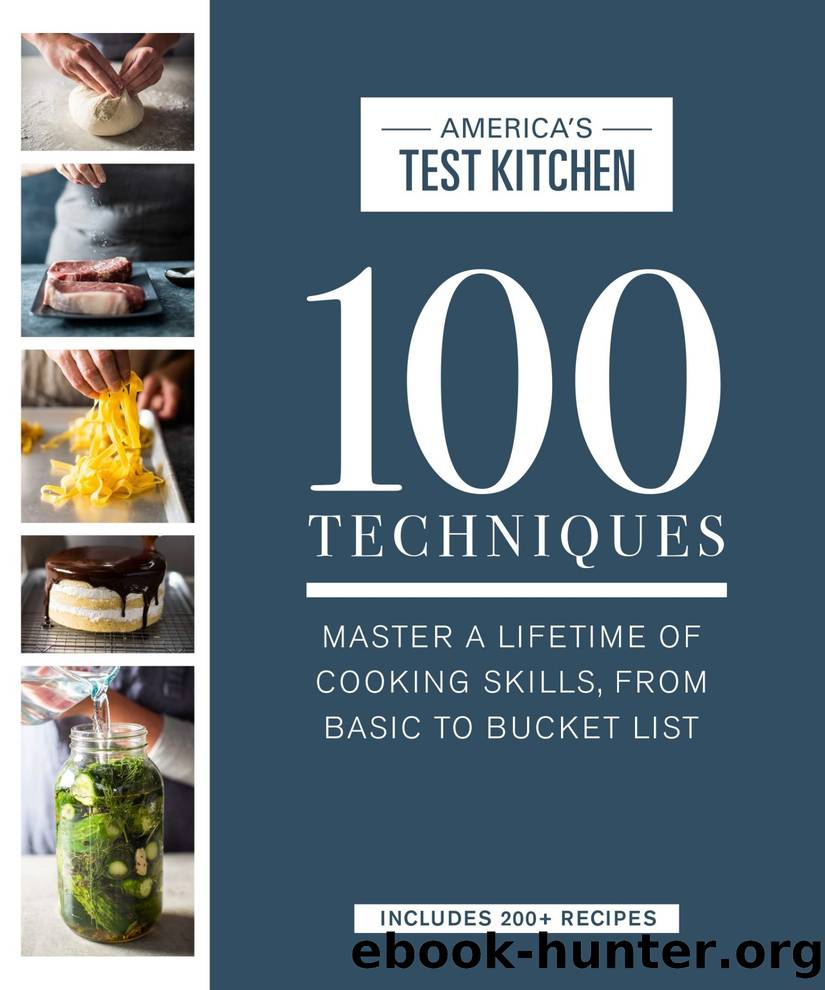100 Techniques: Master a Lifetime of Cooking Skills, From Basic to Bucket List by America's Test Kitchen

Author:America's Test Kitchen [Kitchen, America's Test]
Language: eng
Format: epub
Tags: Cooking, Methods, Gourmet, Reference
ISBN: 9781945256936
Google: HQfWDwAAQBAJ
Amazon: 1945256931
Publisher: America's Test Kitchen
Published: 2020-04-07T00:00:00+00:00
Start with the Oven for Perfect Pan Roasting
The enviable goal of pan-roasting meat is to achieve supercrispy texture on the exterior of the food while cooking the interior to a perfect degree of juicy doneness. The most common approach involves stovetop followed by oven: searing first in a skillet on the stovetop to brown the exterior and then transferring it to a hot oven to finish cooking through. But for the most spectacular deep-brown crust and uniformly juicy and properly cooked interior, we often do the opposite.
The problem with searing the meat before transferring it to the oven is that, in order for the surface of meat to brown, it first has to lose the water it contains. Blasting raw meat on the stovetop with high heat long enough to dry out the surface will also start to overcook the layer below the surface. In the high, prolonged heat of the oven that follows, the meat ends up turning dry throughout, with a gray band of overcooked meat around the exterior.
So instead, sear the meat on the stovetop after roasting it in the oven. We particularly favor this hybrid cooking technique, known as reverse searing, for small whole roasts and thick racks, ribs, chops, and steaks. It involves first roasting the protein gently in a low oven until nearly done. This gently renders fat and minimizes the temperature difference between the meat’s center and its exterior, so the meat cooks through evenly from edge to edge. This process also dries the exterior of the meat. Then, since the exterior is already dry, the meat’s surface browns much more quickly once transferred to the stovetop. With this method, there’s no time for the meat beneath the surface to overcook, and the food can also maintain a better crust since searing is the last step.
Don’t be tempted to skip the stovetop sear and instead blast the meat under the broiler. The radiant heat of the broiler doesn’t work as quickly as direct contact with a hot metal pan, so even if you crank up the oven, the surface of the meat won’t develop a crust quickly enough and the interior will overcook.
Download
This site does not store any files on its server. We only index and link to content provided by other sites. Please contact the content providers to delete copyright contents if any and email us, we'll remove relevant links or contents immediately.
100 Techniques: Master a Lifetime of Cooking Skills, From Basic to Bucket List by America's Test Kitchen(914)
Barefoot in Paris: Easy French Food You Can Make at Home by Ina Garten(806)
Eating Out Loud : Bold Middle Eastern Flavors for All Day, Every Day: a Cookbook (9780593135884) by Grinshpan Eden(768)
Wheat Belly by MD William Davis(756)
The Flavor Equation by Nik Sharma(754)
The Curry Guy Thai by Dan Toombs(741)
Dumplings and Noodles by Pippa Middlehurst(734)
To Asia, With Love by Hetty McKinnon(726)
MasterChef the Classics with a Twist by MasterChef(684)
A Blissful Feast by 449943184(674)
Baking by Dorie Greenspan(672)
Gordon Ramsay Quick and Delicious: 100 Recipes to Cook in 30 Minutes or Less by Gordon Ramsay(666)
Fix-It and Forget-It Mediterranean Diet Cookbook by Hope Comerford(666)
Betty Crocker Kids Cook (Betty Crocker Cooking) by Betty Crocker(644)
Food on the go: Sumptuous Food Truck Recipes by Heston Brown(633)
Bon Appetit, Y'all: Recipes and Stories From Three Generations of Southern Cooking by Virginia Willis; Ellen Silverman(616)
The World Cookbook by Jeanne Jacob-Ashkenazi(612)
The Chopped Cookbook: Use What You've Got to Cook Something Great by Food Network Kitchen(586)
The Soup Cookbook : 100 Best Recipes by Michelle Smith(574)
